La Danse Caraibe, ‘Crocodile Tears’
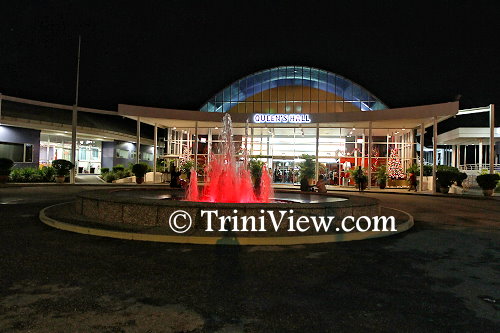
Queen’s Hall, St. Ann’s, Port of Spain
La Danse Caraibe, one of Trinidad and Tobago’s well-known dance schools at #32 Luis Street, Woodbrook, Port of Spain, presented their bi-annual dance production titled “Crocodile Tears” on Saturday 29th and Sunday 30th November, 2014, at Queen’s Hall, St. Ann’s, Port of Spain.
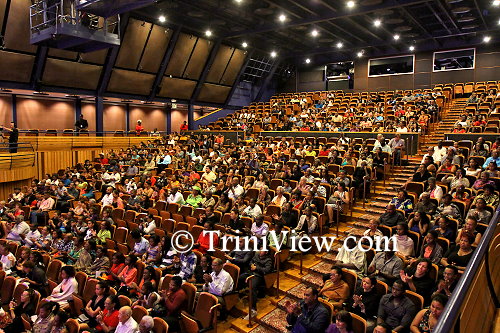
Cross section of the audience
The programme emphasized that the world has become a place where people are not paying attention to serious problems, and as a result La Danse Caraibe has chosen to highlight a few of these issues, through the medium of dance. Such issues included issues of abused children, the [neglected] elderly, pollution, murders, pollution, suicide, violence and fraudulent governments. The show featured a diverse selection of styles and genres that spanned the range of modern, folk, hip hop, and tap genres and were thoroughly enjoyed by the audience.
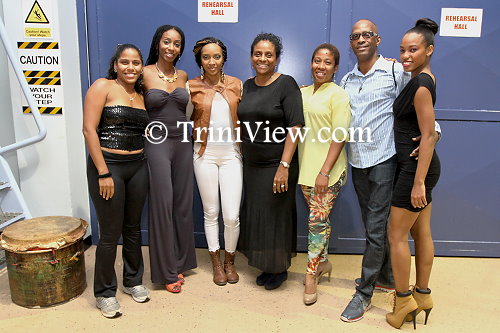
Choreographers, Candice Ellis, Makeba Gabriel, Takiyah Springer, Heather Henderson-Gordon, Arlene Frank, Gregor Breedy and Marielle Dos Santos
The production featured the following choreographers and their works:
Heather Henderson-Gordon – “The Earth Cries”, “Viruses”, “Are you caring or just don’t give a ….damn?” and “Death Rage”; Gregor Breedy – “Macabre Ritual in Morne Diablo”; Makeba Gabriel – “Crab and Callaloo”; Arlene Frank – “Jesters in the Court”, “Punitive Measures” and “Political Assassins”; Marielle Dos Santos – “Cry Wolf”; Takyah Springer – “Forever Young”; and Candice Ellis – “Weeping Rhythmic Estatic Revolution”.
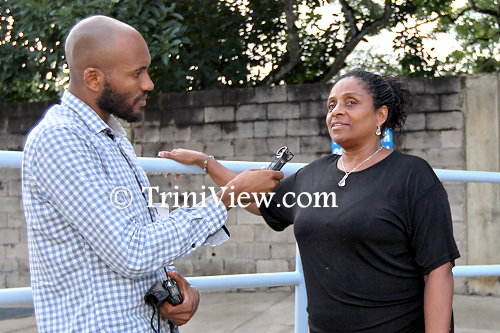
Heather Henderson-Gordon being interviewed by a TriniView.com reporter
Founder of La Danse Caraibe, Heather Henderson-Gordon was on hand to share her thoughts around the production:
“The name of this show is Crocodile Tears. We have a bi-annual show and its mainly to get the kids into performing and understanding the stage and rules and the discipline. It is part of the school’s all-inclusive plan. This year Crocodile Tears is about those things called “cry wolf”, when a child does things to attract you but it is not really real and then when something really happens, the parents are not taking him on. It also symbolizes those things in life we see but don’t really take heed of, or think that you cannot do anything because you are only one [person].”
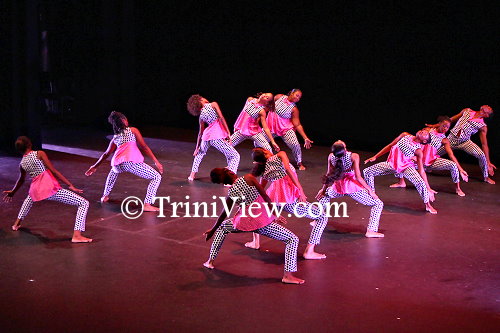
Dancers perform Arlene Frank’s choreography “Jesters in the Court”
The show opened with Arlene Frank’s dance piece titled “Jesters in the Court” followed by “Punitive Measures” and “Political Assassins”. About her last piece Frank explained:
“Political Assassins shows how we have a lot of corruption going on in our government. So they are the political assassins who are taking people’s money unbeknownst. They are not having any regard for the straight line which you are supposed to follow, which would lead them to a better life at the end of it all. Dance is about telling a story, and it is close to drama except that there are no words, so the audience hopefully should be able to grasp based on whatever is on the programme and connect it to the dance that they are seeing.”
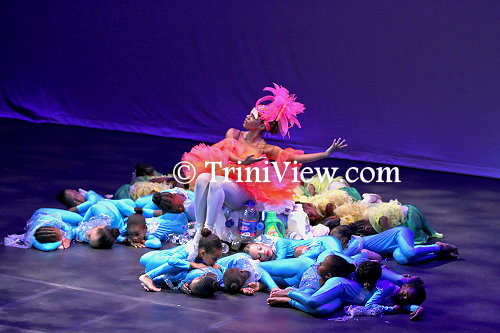
Dancers perform Heather Henderson-Gordon’s choreography “The Earth Cries”
The second dance performance presented was Heather Henderson-Gordon’s piece titled “The Earth Cries”. Reflecting how humans are killing this earth. This piece was a flurry of movement as many children depicting flowers danced on stage, visited by the glorious Scarlet Ibis bird, only to be destroyed by wanton pollution in the form of plastic deposited in their environment.
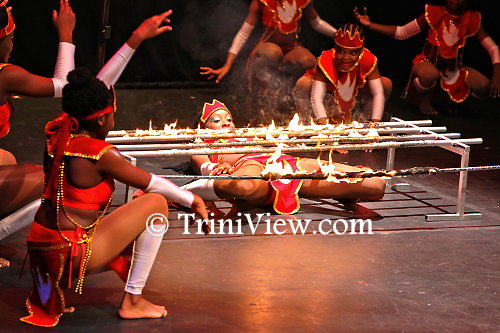
Makeba Gabriel performs her own choreography titled “Crab and Callaloo”
One of the most exciting aspects of the show was the limbo dance titled “Crab and Callaloo”. To the pulsating rhythms of accompanying drummers, dancers limboed gracefully under the flaming bars. The climax of the dance was when five flaming bars were lowered very close to the ground and the choreographer for this piece, Makeba Gabriel, limboed underneath without touching the bar or being burnt to thunderous appreciation from the audience.
Ms. Gabriel shared her thoughts with Triniview.com:
“I have been working with Heather almost six years now. We have limbo every Wednesday for an hour. Our segment is very spicy. Limbo has a tradition of the fire, so we incorporate that. I am just here to share my experience with them as well. I am dealing with the age group of five to sixteen years. It has its moments, but it is really fun.”
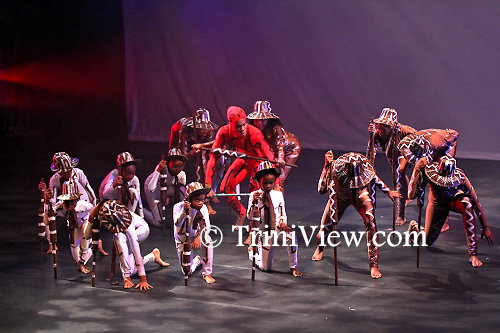
Dancers perform Gregor Breedy’s choreography “Macabre Ritual in Morne Diablo”
Another outstanding performance was Gregor Breedy’s piece titled “Macabre Ritual in Morne Diablo”. Described as a contemporized folk tale about the game of mischief, with the children representing Douens, the females represented the La Jablesse and the male dancer as a human.
According to Breedy:
“It is a contemporary folk piece about the La Jablesse and the Douens and how they approach humans when they come into their space. They lose them into the forest first and they pretend to like the persons, so it is always fake. What I am doing is taking our folktales and putting them into a more contemporary position where it can be used universally.”
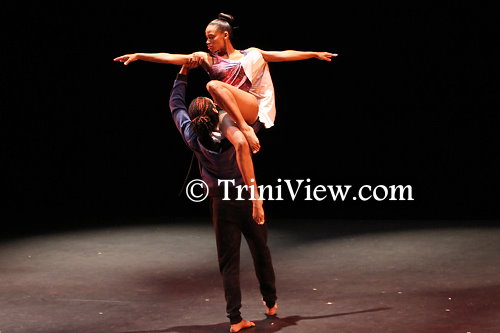
Marielle Dos Santo performs her own chorepgraphy titled “Cry Wolf”
Marielle Dos Santos performed her own choreography “Cry Wolf”. She also performed in Heather Henderson-Gordon’s piece “Death Rage” and Arlene Frank’s “Political Assassins”. In a brief interview she shared part of her story with Triniview.com:
“I started dancing at two and a half years old under Heather Henderson-Gordon and I have never left. There is a lot of work going into tonight’s show, making sure everybody is on point, the lights on point, [and] the sound is on point. You have to keep practising to make sure everyone is there. It is hard. My piece is dealing with a relationship where my boyfriend’s eyes are too long. Then he keeps coming back and she realises in the end that it is a constant cycle, and then gets over it and leaves him.”
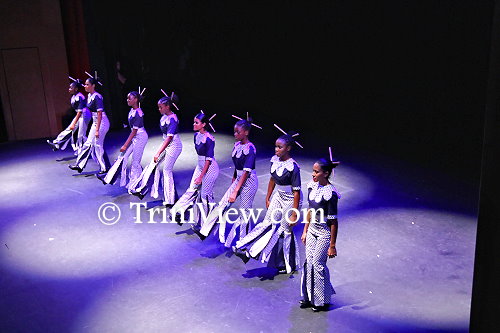
Dancers perform Candice Ellis’s choreography titled “Weeping Rhythmic Ecstatic Revolution”
The night’s other choreographer’s also presented fascinating routines with Candice Ellis’s moving tap dance piece titled “Weeping Rhythmic Ecstatic Revolution” which reflected the movement towards freedom and Takiyha Springer’s hip hop piece, “Forever Young” which depicted a class of old and young genres resulting in a new form, which was a synthesis of the young and the old.
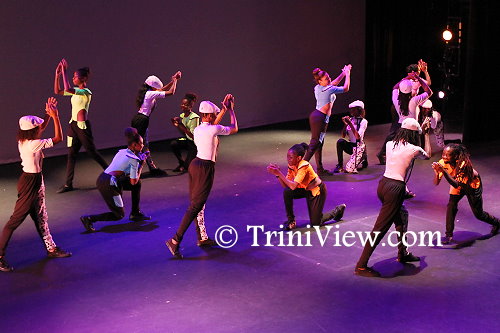
Dancers perform Takiyha Springer’s choreography titiled “Forever Young”
Overall, the dance pieces were very engaging, and the enthusiasm and practice that went into them were evident. This well-organised production was a fitting expression of dance to mark La Danse Caraibe’s twenty-eighth year as a dance company.
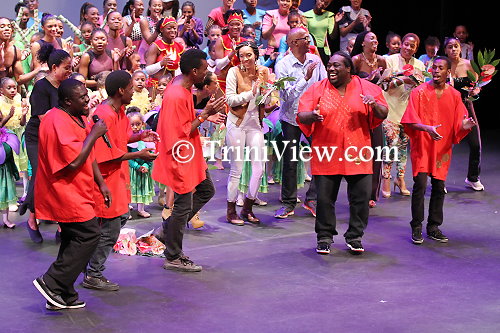
Henderson-Gordon and her production crew on stage
Transcribed Interviews
Heather Henderson-Gordon
Heather Henderson-Gordon: The name of this show is Crocodile Tears and the name of the school is La Dance Caraibe. We have a bi-annual show and it’s mainly to get the kids into performing and understanding the stage and rules and the discipline. It is part of the school’s all-inclusive plan. This year, Crocodile Tears is about those things called “cry wolf”: when a child does things to attract you but it is not really real and then when something really happens the parents not taking him on. It also symbolizes those things in life we see but don’t really take heed of, or think that you cannot do anything because you are only one [person].
Dance Caraibe is a school. We start at three years old but we have two year olds to seniors and adults. It’s really about training them. They love it. They are excited … sometimes too excited. I am tough when it comes to the training. I insist that it must be clean. We started our first run [of practises] on Sunday. We do two on a Sunday and one on a Monday, one on Tuesday.
Persons coming to the show can expect variety as the school does folk, modern, limbo and ballet, hip hop and tap dance. The school’s emphasis is to get the child so diversified so that they can go to any university in the world and do our local stuff. You can’t leave Trinidad and not know our local stuff.
My piece is “The Earth Cries” and that is about the earth dying. I thought of doing cane, but then I thought children … flowers, so I did something more inviting to the eye. So we are showing that they are dying because of all the bottles and plastic all over. Our Scarlet Ibis is in it, so it has something hinting at our local flora and fauna … hinting that we are not doing enough for our environment.
I have another piece called “Death Rage”. People are dying all around us and there are different types of death. Another choreographer did a piece on age. We have more old people and we have to deal with them. You have things about the young and the old. The young is being neglected too and there is violence against children. We have quite a few things that are societal issues.
The children I reach through dance can use it to discipline themselves in terms of time-management. ]When children can build from three years and do dance alongside studies, later on they have better time-management skills. It also has them working with their peers. They also work in groups with other people, they speak better … it is a whole social thing that you learn. You[/b] learn how to deal with hardships, how to deal with people, how to get here, how to travel. The whole process is about learning far more that just dance.
Gregor Breedy
Gregor Breedy: I am Gregor Breedy, a choreographer with Crocodile Tears, in the folk section. I have been dancing for the past years. I started off dancing with the Trinidad East Indian Dance Company and then moved into the Barataria Community Council. I got a scholarship to go away to the Toronto Dance Theatre and later became the choreographer at the Barataria Community Council. I have won best choreographer in that area in 1997 and best male dancer for three years in Best Village. Later on, I moved to Prizgar Lands, Kelly Village and I won best choreographer for five years there. I am here at Heather’s show Crocodile Tears doing a piece called “Ritual”. It is a contemporary folk piece about the La Jablesse and the Douens and how they approach humans when they come into their space. They lose them into the forest first and they pretend to like the persons … so it is always fake.
What I am doing is taking our folktales and putting them into a more contemporary position where it can be used universally. I went to Peru and I saw them use the Amerindian dancing and the dance company only does Amerindian stuff in their ballet. So I got the idea to mix the contemporary styles with the folk and it is working well. My next venture is that I want to do the Dame Lorraines and other Carnival characters of Trinidad and Tobago. Right now, I am the artistic director of the Andre Ettiene Dance company and we are doing a lot of contemporary work with the midnight robber.
I still feel that a lot more focus and finance should be into dance. Trinidad and Tobago’s culture was based from the African slaves and we know that with the African slaves came the oral traditions, their dance and music. Trinidad and Tobago, especially the National Carnival Commission, when they are doing Carnival they tend to leave out dance and Carnival was based on dance.
Every dance is basically telling a story, especially in the African folklore. Africans tell stories with their dances; Indians do it too. It’s not just a story that is vague; it’s not a fairy tale … it is what is happening on the ground, social and political issues. If you want to tell a tale of a woman who has been scorned or hurt by her husband you can use the La Jablesse. If you want to tell the tale of a child who died during childbirth you can use the douen. You have different folk and carnival characters that can produce those things so it is very easy to produce a dance if you know the folklore.
I think that Heather Henderson-Gordon has done a really wonderful job with the children. Know that they are from two years old all the way up to twenty-seven. She has taken up the mantle of working with a variety of ages. She is especially strong in imparting knowledge of dance to the children. I am watching her work and I think the themes are quite advanced and the children understand it very well. They know what they are doing.
Makeba Gabriel
Makeba Gabriel: I am the choreographer for the limbo segments of the company. I have been working with Heather for almost six years now. We have limbo every Wednesday for an hour. Our segment is very spicy. Limbo has a tradition of the fire, so we incorporate that. I am just here to share my experience with them as well. I am dealing with the age group of five to sixteen years. It has its moments, but it is really fun. Culture makes us one: it does not matter what your background is. It just lets you know that you can share different views but yet come to one understanding where culture is concerned. The audience can expect excitement, more fun and plenty fire … just a great choreography where the children get to express themselves. They don’t have to be too serious in this piece … it is just about having fun. Most of the children come shy, as it is their first time … some of them … it gets them to open up a little. Then you get the parents saying, “I never knew my children would have enjoyed this.” It is a great thing that Heather has been having folk dance in her company for the last six years.
Makeba Gabriel
Arlene Frank: I am one of the modern dance teachers in La Dance Caribe as well as choreographer for three pieces. Tonight you will get a variety of dance styles in this show: modern, ballet, tap and folk … the full works, including a violinist. My piece is supposed to be one that pertains to falling off the line. One of them is called “Political Assassins” which shows how we have a lot of corruption going on in our government. So they are the political assassins who are taking people’s money unbeknownst. The other one is with regards to corporal punishment which was removed and is causing a lot of problems with the students. They’re not having any regard for the straight line which you supposed to follow, which would lead them to a better life at the end of it all. Dance is about telling a story, and it is close to drama except that there are no words, so the audience hopefully should be able to grasp based on whatever is on the programme and connect it to the dance that they are seeing. Hopefully, it should convey the message that we are trying to get across to the general public. I hope tonight goes “splendiferous”. I hope the girls and boys dance their hearts out and entertain our audience tonight.
We are hoping to get more boys involved as the boys have a lot of talent but they are afraid to dance as they feel it will label them to be something different. So far, our general attendance is girls or women. There are excellent male dancers. It is sad as people always want them. There is need for male dancers to do lifts, or partnering work. The girls are very skilled though, we play both genders.
Marielle Dos Santos
Marielle Dos Santos: I am a dancer and choreographer. I am in three pieces: “Cry Wolf”, “Death Rage” and “Political Assassins”. I started dance at two and a half years old under Heather-Henderson Gordon and I have never left. There is a lot of work going into tonight’s show, making sure everybody is on point, the lights on point, the sound on point. You have to keep practicing to make sure everyone is there. It is hard. The whole show is titled “Crocodile Tears” and you have pieces on domestic violence, pollution, crime, suicide and gangs. My piece is dealing with a relationship where my boyfriend’s eyes are too long. Then he keeps coming back and she realises in the end that it is a constant cycle, and then gets over it and leaves him. The children are very energetic. We usually have them in the second half of the show, but this year we are having them in the first half so we have to keep them occupied for the second half of the show. We have a monitor backstage … they want to see Aunty and Uncle dancing on stage.
Takiyah Springer
Takiyah Springer: I am the hip hop choreographer. I tried all styles, but when I did hip hop I fell in love so I stuck with it. The name of my piece is “Forever Young”. It is basically from old school to new school, there was always dance. We mix the old school and the new school and in the end, they appreciated both sides. They came together and danced together. Preparing for tonight’s show was a bit strenuous as I had a lot going on but I enjoyed every moment of it. I cannot wait to see the girls perform tonight. I do international competitions and workshops. I did a show this year called “Living the Dream” and I want to take it international. So my aim is to get out there and show people my work and to keep progressing.
Candice Ellis
Candice Ellis: I am the tap dance choreographer and my piece is called “Weeping Rhythmic Ecstatic Revolution”. My piece is based on how tap dance evolved from African American slaves, how it came about, how slavery took place and the movement to freedom. A lot of people, especially my students, when I asked them what they knew about tap dancing, they knew nothing about it. When I told them it came from slavery, they were all very shocked. I work with age ten straight up to teens. I learn stuff from them, and they learn from me so it is pretty cool. I specialize in tap, modern and jazz dance but I teach particularly tap now. I like the noise. It is nice, to see feet moving and try to find out how it is making that sound. There are different things you can do with it.